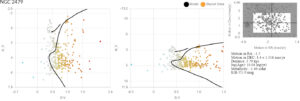NGC 2479 is an old-aged Open Cluster, which is located in the Southern Hemisphere. The cluster is located in Puppis Constellation. This cluster was discovered by William Herschel on 4th March 1970. The cluster is located 1,200 Parsecs away from Earth.
Background Information on Types of Clusters
A Cluster can be either an open cluster or a closed cluster. An open cluster means that the stars are more spread apart and therefore are more ‘open’. Even though the stars are born relatively at the same time the center of the cluster has a low gravitational attraction meaning the stars will disperse more.
If the cluster is closed then the gravitational attraction of the center is high and the stars will be more centralized and much brighter in the middle due to the luminosity.
Studies on NGC 2479 after William Herschel
NGC 2479 was re-examined in 2010 byAndrés E. Piatti and he states that it is a bright cluster with a lot of bright stars in the cluster field. He claims that the diameter of the cluster is 11 arcmin or 660 arcseconds. He also found E(B−V) = 0.10, d= 1.2 kpc and ∼1 Gyr.
My research on NGC 2479
I was given this cluster to observe and study and with the help of Skynet’s telescope at Cerro Tololo Inter-American Observatory, I was able to take some pictures of the cluster. I used Afterglow to give the picture some colour to see the colour of the stars which would later help me to determine the age of the cluster. Even though my research was not as complex as the astronomers above I have come to find similar results and William Herschel and Andrés E. Piatti.
In Fig 1.1 I used a stacked image of red, blue, and green to make the coloured picture which shows how the cluster looks like and what colours the stars are.

(Fig 1.1) This is a staked and reddened NGC 2479
RESULTS

(Fig 1.2) The graph above was made using Cluster Pro of NGC 2479.
Proper motion in RA = -1.5 ± 2.2
Proper motion in Dec = 1.4 ± 1.316
Distance (with error %) = 3.79 ± 30%
Log(Age) = 10.04 (yr)
Metallicity = -1.49
E(B-V) = 0
After getting the data collected from afterglow the graph above I gathered that the Cluster was old since it has a big number of yellow and white stars that are in the main sequence.
Conclusion
After analyzing the cluster it was very interesting how I learned the basics of the formation of clusters and why they form the way they do. I enjoyed this assignment a lot and I wish next time if I get to do such an assignment I can observe a closed cluster that is born recently with all the nebula there for some nice pictures.